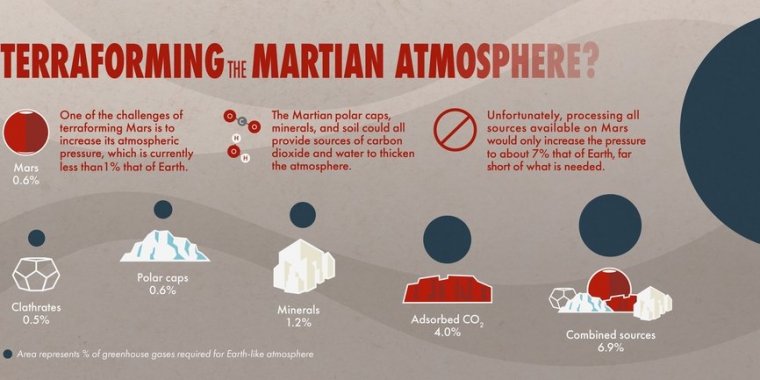| News / Space News |
Mars Terraforming Not Possible Using Present-Day Technology
Science fiction writers have long featured terraforming, the process of creating an Earth-like or habitable environment on another planet, in their stories. Scientists themselves have proposed terraforming to enable the long-term colonization of Mars. A solution common to both groups is to release carbon dioxide gas trapped in the Martian surface to thicken the atmosphere and act as a blanket to warm the planet.

This infographic shows the various sources of carbon dioxide on Mars and their estimated contribution to Martian atmospheric pressure. Credits: NASA Goddard Space Flight Center
However, Mars does not retain enough carbon dioxide that could practically be put back into the atmosphere to warm Mars. Transforming the inhospitable Martian environment into a place astronauts could explore without life support is not possible without technology well beyond today’s capabilities.
Although the current Martian atmosphere itself consists mostly of carbon dioxide, it is far too thin and cold to support liquid water, an essential ingredient for life. On Mars, the pressure of the atmosphere is less than one percent of the pressure of Earth’s atmosphere. Any liquid water on the surface would very quickly evaporate or freeze.
Proponents of terraforming Mars propose releasing gases from a variety of sources on the Red Planet to thicken the atmosphere and increase the temperature to the point where liquid water is stable on the surface. These gases are called “greenhouse gases” for their ability to trap heat and warm the climate.
Carbon dioxide (CO2) and water vapor (H2O) are the only greenhouse gases that are likely to be present on Mars in sufficient abundance to provide any significant greenhouse warming.
But there is not enough CO2 remaining on Mars to provide significant greenhouse warming were the gas to be put into the atmosphere; in addition, most of the CO2 gas is not accessible and could not be readily mobilized. As a result, terraforming Mars is not possible using present-day technology.
Although Mars has significant quantities of water ice that could be used to create water vapor, previous analyses show that water cannot provide significant warming by itself; temperatures do not allow enough water to persist as vapor without first having significant warming by CO2.
Also, while other gases such as the introduction of chloroflorocarbons or other fluorine-based compounds have been proposed to raise the atmospheric temperature, these gases are short-lived and would require large-scale manufacturing processes.
The atmospheric pressure on Mars is around 0.6 percent of Earth’s. With Mars being further away from the Sun, researchers estimate a CO2 pressure similar to Earth’s total atmospheric pressure is needed to raise temperatures enough to allow for stable liquid water.
The most accessible source is CO2 in the polar ice caps; it could be vaporized by spreading dust on it to absorb more solar radiation or by using explosives. However, vaporizing the ice caps would only contribute enough CO2 to double the Martian pressure to 1.2 percent of Earth’s, according to the new analysis.
Another source is CO2 attached to dust particles in Martian soil, which could be heated to release the gas. The researchers estimate that heating the soil could provide up to 4 percent of the needed pressure. A third source is carbon locked in mineral deposits.
Using the recent NASA spacecraft observations of mineral deposits, the team estimates the most plausible amount will yield less than 5 percent of the required pressure, depending on how extensive deposits buried close to the surface may be.
The majority of Mars’ ancient, potentially habitable atmosphere has been lost to space, stripped away by solar wind and radiation. Of course, once this happens, that water and CO2 are gone forever.
Even if this loss were prevented somehow, allowing the atmosphere to build up slowly from outgassing by geologic activity, current outgassing is extremely low; it would take about 10 million years just to double Mars’ current atmosphere.
Another idea is to import volatiles by redirecting comets and asteroids to hit Mars. However, the team’s calculations reveal that many thousands would be required; again, not very practical.
Taken together, the results indicate that terraforming Mars cannot be done with currently available technology. Any such efforts have to be very far into the future. (NASA)
YOU MAY ALSO LIKE

